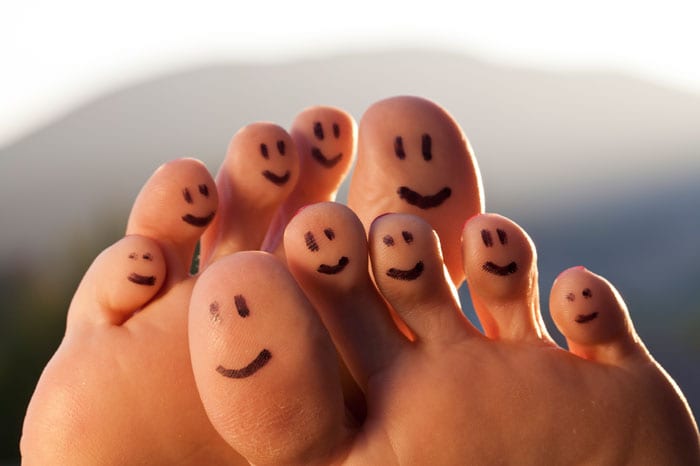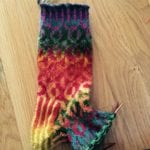Why Do My Toes Hurt?
One day you start to notice that your toe hurts. You don’t know why. Maybe your shoes are too tight or don’t fit right because the heel is too high. Or, if you participate in a high impact or running sport, your toes are always being pushed and jammed to the front of your shoes. Whatever it is, you continue to ignore the pain, and you keep on going.
No matter what you do your toe keeps hurting. You try stretching and pulling each toe, or not wearing shoes, but your toe still hurts! You may be on your way to permanently damaging your toe, giving yourself a condition known as “hammertoe”!
What is Hammertoe?
Most hammertoes are caused by wearing ill-fitting, tight or high-heeled shoes over an extended period of time. Shoes that don’t fit well can crowd the toes, putting pressure on the toes and causing the tendon to shorten and curl downward. The tendons on the top of the toe will also tighten over time because they cannot stretch to their full length. Eventually, these tendons will stay shortened and the toes will become permanently bent even when shoes aren’t worn.
Hammertoe – Things to Watch out For
- People whose second toe is longer than the big toe or are flat-footed are more likely to get a hammertoe, but it can happen with anyone.
- A hammertoe occurs when the muscle in a toe isn’t working properly or is too weak causing increased pressure on tendons and toe joints to support the toe. To bend and straighten each toe, we need strong toe muscles. If the toe stays bent too long, a hammertoe develops.
- Hammertoe also can be caused by a bunion. The enlargement (at the base of the big toe or even at the base of the 5th toe) represents a misalignment of the big toe joint and, in some cases, additional bone formation. The misalignment causes the big toe to point inward towards the smaller toes. This deformity is progressive and will increase with time. Eventually, the big toe can overlap and crowd the smaller toes, causing them to shift outward.
The pain may be subtle at first, but then it becomes relentless. The pain can also cause other foot problems like corns and bursitis.
Hammertoe can be avoided if you don’t ignore the pain!
Ouch Alert!
- Pay attention to what shoes hurt your feet and where.
- Are your toes being pushed to the front of the shoes and causing the toe(s) to jam? (shoes too small, high impact sports, or high heels)
- In the initial pain stage, don’t ignore pain or the discomfort in the toes or the ball of the foot.
- A callus that develops at the base of the second and third toes can become an issue causing the ball of the foot to be slightly raised. Walking can become painful and can change your gait.
- Bunions that get bigger over time cause the toes to be pushed outward and become misaligned.
What Can You Do to Prevent Hammertoe(s)?
Most cases of hammertoe are preventable by wearing proper shoes that fit and give the toes plenty of room to move. Some recommended guidelines include:
- Avoid shoes that are too tight or short, or have high heels, pointed or narrow toes.
- Choose shoes with wide or boxy toes.
- Choose shoes that are a half-inch longer than your longest toe.
Toe Exercises
Foot exercises also can help to maintain or restore the flexibility of the tendons. If you notice the beginning signs of hammertoe, try these simple exercises you can do while sitting or watching TV:
Toe Stretching: Gently massaging each toe, then gently pull each toe in all directions by rotating each toe clockwise and counterclockwise several times and then gently pulling up each toe.
Toe Pick-Up: Place a small towel, golf ball or pencil on the floor and, using your toes only, pick-up the item off the floor and hold, starting with a count of 5 and increasing to 10 seconds. By doing this exercise for several weeks, your toes will become stronger.
Toe Curling: Curl your toes up and the down for a set or two of 10 and repeat throughout the day.
Traditional Treatment
Some simple treatments include:
- Splinting the toe to keep it straight to stretch the tendons.
- For toe support, small over- the- counter pads or small cushions placed under the 2nd and 3rd toes will help decrease discomfort.
- Exercise the toes to relax the foot tendons.
- Wear shoes that fit properly and allow toes plenty of room to stretch out
If those don’t work, surgery might be recommended. Surgery for hammertoe involves straightening the toe by cutting the tendons to make them flexible again. This minor surgery may not always be the best solution; many people continue to experience pain after the procedure.
When to call a Professional?
If you start to experience pain in your toes or feet that lasts longer than several weeks or if one of your toes begin to curl, it’s time to make an appointment with a primary care doctor, podiatrist or pedorthist.
A podiatrist is a doctor of podiatric medicine (DPM), also known as a podiatric physician or surgeon. Podiatrists diagnose and treat conditions of the foot, ankle, and related structures of the leg.
A pedorthist specializes in the modification of footwear and employ supportive devices to address conditions which affect the feet and lower limbs.
Want to Incorporate Holistic Methods?
Try working with a Certified Reflexologist or Massage Therapist. Tell the therapist what going on with your feet so that he/she can focus on the problem area along with any other health issues. The therapist will develop a program that will help your feet. Before you know it your feet will feel better and your toes will be happy.
Final Thoughts
Remember hammertoe can be avoided. Be kind to yourself by buying shoes that fit. Not only can bad fitting or high heel shoes hurt your feet, but they can cause pain in the hips and back and also age your knees prematurely.
About the Writer – Helen Chin Lui is a Certified Reflexologist, Certified Energy Medicine, and Reiki Master and Teacher. She is the owner of the Healing Place in Medfield, MA US. She specializes in helping people with chronic digestive disorders, chronic pain and balances hormones naturally. To find out how Reflexology and Energy Medicine can help you, please schedule a FREE 60-minute consultation by calling 508 359-6463.
For the Healing Place Medfield’s free report “Proven Alternative Ways to Heal Common Chronic Digestive Problems: What Your Doctor Doesn’t Know Can Keep You From Healing” click here.










 The Healing Place LLC helps all ages to find relief from chronic pain, chronic digestive problems and balance hormones naturally. We practice COVID19 safety. Don’t forget to check on our online school HealingPlaceEnergySchool.com. Thank you.
The Healing Place LLC helps all ages to find relief from chronic pain, chronic digestive problems and balance hormones naturally. We practice COVID19 safety. Don’t forget to check on our online school HealingPlaceEnergySchool.com. Thank you.
It makes sense that you can prevent hammertoe by wearing shoes that fit you properly. My wife recently received some running shoes from her sister as a gift, but she has noticed that one of her toes has started to hurt a lot ever since she started jogging in her new shoes. Now that I know that she may be developing hammertoe, I’ll seek professional help.